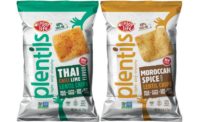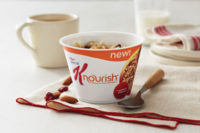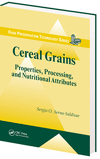Retail Product Trends Annual | Breakfast Cereals, Snack Bars
2017 Breakfast & Bars Trends: Make a Clean Break
Breakfast cereal and bar makers push new formats, clean label with few ingredients






It is no secret that these have been challenging times for breakfast cereal. One of the original convenience foods, breakfast cereal is no longer seen as convenient by younger consumers increasingly inclined to avoid milk and cereal in the morning. Now in favor are cleanup-free, hand-held breakfast foods that can be eaten on-the-run.
Making breakfast cereal more portable and “snackable” powered new product innovation in 2016 as cereal giants like Kellogg and General Mills sought to put breakfast cereal back on a growth footing. GlobalData (formerly Canadean) expects breakfast cereal to return to growth, forecasting a compound annual growth rate (CAGR) of 0.7% for the period from 2015 to 2020.
General Mills focused on “milk optional” breakfast cereal. Fitting this description was Tiny Toast – a new cereal designed to look like miniature pieces of toast, each sprinkled with real strawberries or blueberries. General Mills’ first new cereal brand in 15 years, Tiny Toast went after older teens and young adults with a marketing effort geared toward social media platforms like Snapchat and Facebook.
Nature Valley Baked Oat Bites went in a similar “milk optional” direction with cinnamon-baked oat bites with a hearty crunch and a “light, sweet” drizzle. General Mills also added a pair of snackable, cluster-type cereals under the Nature Valley banner in 2016: Chocolate Oat Clusters and Honey Oat Clusters.
Kellogg took a more direct approach toward the “on-the-go” opportunity in 2016 with Kellogg’s To Go Breakfast Mix. Packaged in a resealable pouch with a narrowing bottom to fit into a car cup holder, To Go reassured consumers that “no milk is needed” to enjoy flavors like Salted Caramel and Praline Almond. Kellogg opted for the stand-up pouch partly based on research that found consumers were already stuffing cereal into plastic bags to take it “on the road.” Kellogg’s pouch formalized what consumers were already doing.
Granola is uniquely suited to snacking – a fact that helped make 2016 a banner year for granola cereal innovation. Kellogg gave the trend its endorsement by extending Raisin Bran cereal into granola for the first time via a two-flavor line including Cranberry Almond Granola.
Granola has become a focal point for breakfast cereal innovation because it is perceived to be more healthful than traditional flaked cereals. Granola also works well as a snack or topping for other foods like Greek yogurt, which itself has grabbed a chunk of the breakfast market.
PepsiCo’s Quaker unit was also on trend with granola in the form of Quaker Real Medleys Super Grains Granola Mix featuring whole grain oats and wheat with eclectic ingredients like flaxseed, red quinoa, and amaranth.
Quaker went clean label with Quaker Simply Granola, alluding to a lack of artificial flavors or colors and the presence of real almonds, apples, and cranberries as ingredients. Also touching on a fondness for simpler times, Cascadian Farm Organic Farm Stand Harvest Granola encouraged consumers to visit its “home farm” in Skagit Valley, Wash., which has been in operation since 1972.
Innovation in vegan breakfast cereals could rise in 2017 if Kellogg’s Kashi unit is successful with its Kashi GoLean Vanilla Pepita Clusters. The 2016 launch was formulated with red beans, pea crisps, pepitas (pumpkin seeds) and sorghum—all healthful, plant-based ingredients. Kellogg also went in more of a plant-based direction with its Special K Nourish cereal with coconut, quinoa, and almond ingredients. More eclectic was Living Intentions Activated Superfood Cereal in a Banana Hemp flavor made with “alkalizing greens such as spirulina, chlorella, dandelion and live probiotics.”
Speaking of ingredients, breakfast cereal went “transitional” in 2016. “Transitional” means ingredients sourced from farms transitioning from conventional agriculture to organic agriculture. The process can take as long as three years, leaving farmers high and dry in the interim. In 2016, Kashi Dark Cocoa Karma became the first cereal claiming to be made with “transitional wheat.” This trend could gain momentum in 2017 with help from Quality Assurance International’s new “Transitional Certified” mark.
Hot cereal has been a bright spot for the market in recent years, though new product activity cooled in 2016. Noteworthy launches included Powerful Oatmeal, a single-serving cup packaged oatmeal with 20g of protein per serving from the same brand that has become a fixture in cup yogurt. Quaker Bring Your Best Bowl Finalist Variety Pack showcased consumer-driven flavor innovation by offering three finalist flavors from those chosen by consumers at Bringyourbestbowl.com. Lemon Ricotta Pancake, Apple Cheddar Rosemary, and Vanilla Chai were the three winners.
While breakfast cereal is stuck in the mud, things are looking rosy for snack bars. GlobalData (formerly Canadean) projects that sales of cereal bars will grow at a 1.8% CAGR for the period from 2015 to 2020, more than double the growth rate projected for breakfast cereal. Energy bars – tracked separately by GlobalData – are expected to perform even better, with a 5% CAGR over the same period.
Growth projections like this explain why Walmart reportedly asked caffeinated chocolate bar maker Awake Corporation to bring its magic for snack bars in 2016. The company obliged with Awake Energy Granola Chewy Bars, a line of granola bars with as much caffeine as a half cup of coffee along with B vitamins to “fuel the body.” Also going the caffeinated route, R.e.d.d. Research Enhanced Design + Development Superfood Energy Bars featured yerba mate as a natural energy booster with a caffeine boost equal to one-third of a cup of coffee.
This relatively new focus on morning energy enhancement dovetails nicely with GlobalData research confirming a big increase in morning snacking. According to a Q3 2016 survey by GlobalData, 38% of Americans said they snack between breakfast and lunch, a sizeable increase from the 29% that said they snack during this time period as recently as 2014.
These morning snackers had plenty of new options in 2016. Kellogg’s Nutri Grain Fruit & Nut Chewy Breakfast Bars paired almonds with sun-ripened fruit like blueberries and cherries. General Mills’ Nature Valley brand also demonstrated a fondness for almonds with Nature Valley Biscuits with Almond Butter, said to provide long-lasting energy from 14g of whole grains per serving.
Quaker Breakfast Flats Breakfast Bars referenced the thin cookie trend with a flat bar in flavors like Cranberry Almond and Banana Honey, each with 18g of whole grains per serving. Kind Breakfast Bars combined five “super grains” – oats, millet, buckwheat, amaranth and quinoa – for “sustained energy” from 21g of whole grains per serving.
The clean label trend guided snack bar innovation in 2016 as many new launches focused on ingredients. PepsiCo’s Quaker unit made this its reason-for-being for Init Nut & Fruit Bar, promoted with the tagline “It’s what’s Init that matters.” Kind LLC’s new Pressed by Kind No Sugar Added Fruit Bars pressed fruits, vegetables, and chia together for a bar able to stay intact without traditional binders or fillers. Some flavors of Pressed by Kind bars had as few as three ingredients. RXBar Protein Bar actually turned the front of its pack into an ingredient label, listing whole food ingredients like egg whites, almonds, and more, a strategy that may have helped the startup brand gain distribution in Trader Joe’s stores.
A growing number of snack bars referenced terms like “clean” or “clear” in 2016, giving the clean label concept a higher profile. Tracy Anderson Clear Protein & Energy Bars did so with bars made with organic sunflower butter and pea protein. Anderson is known as the “queen of dance cardio” and a trainer to the stars; Target added her snack bars to its shelves in 2016. Muscletech Mission1 Clean Protein Bar claimed to be made with “only protein isolates – no inferior gelatin” with no sugar alcohols or fillers.
Last year also saw snack bar makers become more transparent about protein. Oatmega Grass-Fed Whey Bar was one of the first to talk about using grass-fed whey protein as an ingredient. Gatorade Recover Whey Protein Bar illustrated the rising profile of whey protein. A Q2 2015 survey of American consumers by GlobalData found that just 19% of Americans were “not familiar with” whey protein versus 41% that said the same about pea protein.
But low consumer awareness did not deter snack bar makers from plant protein or other plant-based ingredients. Kellogg’s Kashi brand’s new GoLean Plant Power Bars used pea protein as a signature ingredient. Plant-based protein from cashews and almonds highlighted Curate Kids “crafted with joy” snack bars. The Curate brand marked the entry of a new player—Abbott Laboratories—into snack bars and Curate Kids was conceived to help parents “win the snack time battle” with a between meal snack that does not compromise on nutrition.
Vegetable ingredients also were up-and-coming in 2016 including root vegetables like beets and carrots, partly because vegetables can lower sugar contents and boost nutrition at the same time. Happy Mama Organics Prenatal Soft-Baked Oat Bar used beets and carrots as ingredients. Sweet potatoes, spinach, carrots, and beets found their way into the Clif Kid Organic Z Bar Fruit & Veggie Bar.
The rise of savory flavor innovation is something to keep an eye on in 2017. Kashi Savory Bars Andean Inspired Crunchy Bars—a 2016 entry leveraging flavors like basil and roasted pepper to drive sugar levels down to just three grams per bar—may be a sign of things to come. If nothing else, snack bars are swinging the door open to tart or savory flavor innovation as the debut of Abbott Laboratories’ Curate brand showed in 2016 with new-to-the-category flavors like balsamic fig.
Originally appeared in the March, 2017 issue of Prepared Foods as Make a Clean Break.
2017 Retail New Products Annual
Looking for a reprint of this article?
From high-res PDFs to custom plaques, order your copy today!









